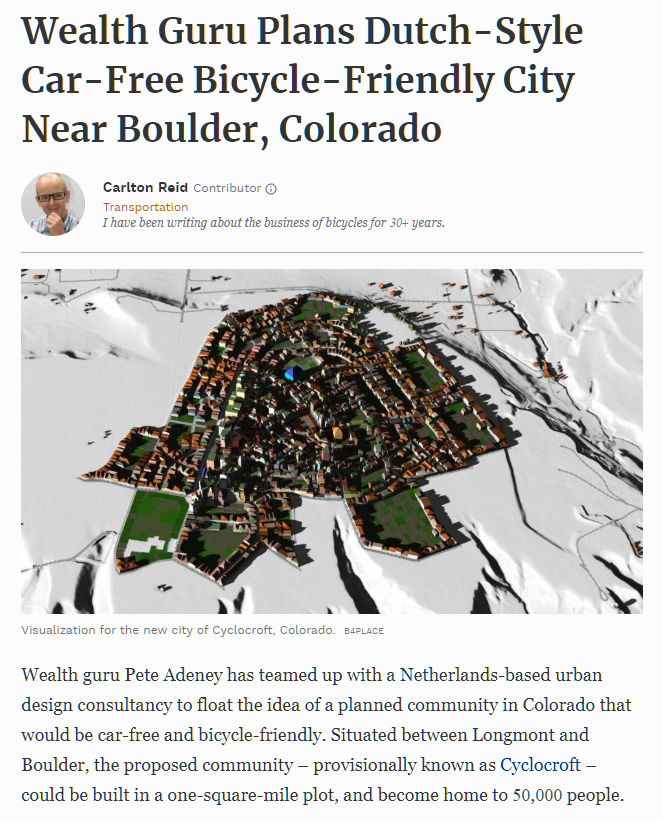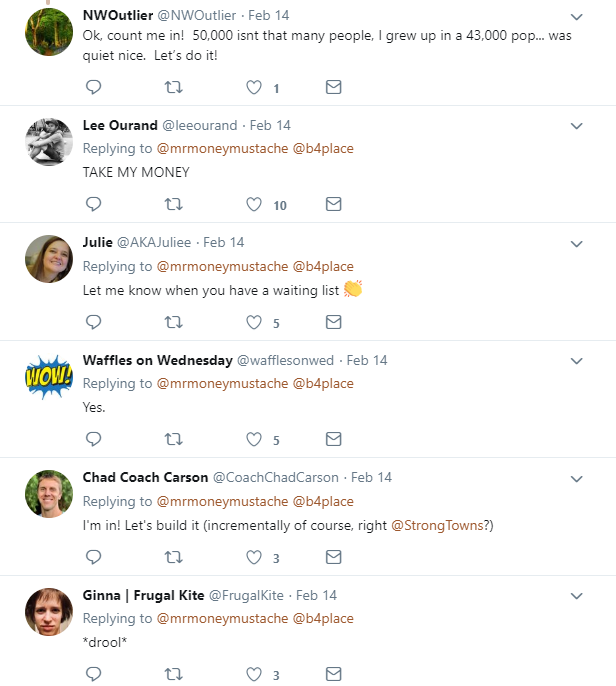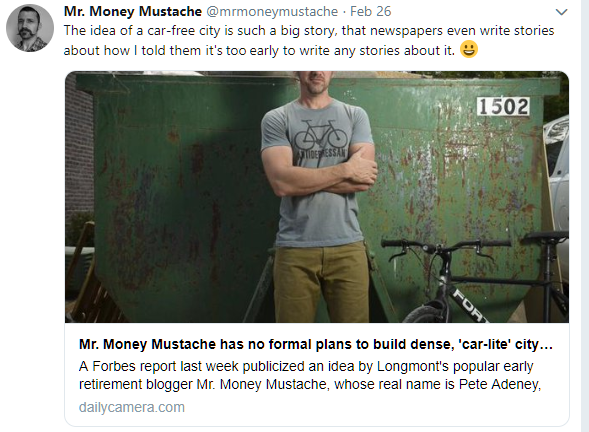How to Create Reality
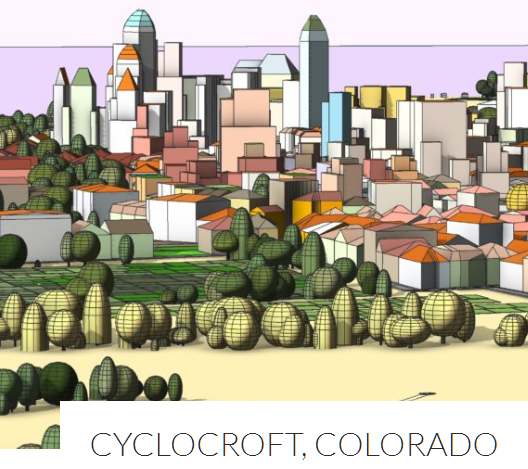
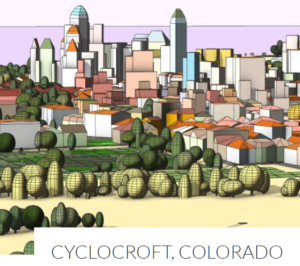 So a funny thing happened on Twitter this week, which almost changed the world a little bit.
So a funny thing happened on Twitter this week, which almost changed the world a little bit.
Someone sent me a beautiful 3-D mockup of a fictional, car-free city of 50,000 people, set in the scenic nook of land* between Boulder, Colorado and Longmont, where I live. It came complete with street plans, detailed descriptions and dozens of cool photos, both real and computer-generated, showing how it would feel to live there. They called it Cyclocroft, in honor of the generally pro-bike stance of Mustachian culture.
This was not out of the blue: these plans came from some long-time readers, who have heard me muse about better cities in the past. Over the last few years, I have come to realize that the fastest way to get my fellow Americans into healthier, wealthier lives is probably just to change the way we lay out our living spaces. Instead of wasting trillions of dollars on separating and isolating ourselves just to accommodate giant racetracks for our gas-powered wheelchairs, we could make everything about 75% less expensive (and many times more fun) by making cities that work without cars.
So anyway, these architects sent me the plans, and I put them up on Twitter with a comment about how they're fictional but boy wouldn't this be a nice way to use a single square mile compared to what we do right now.
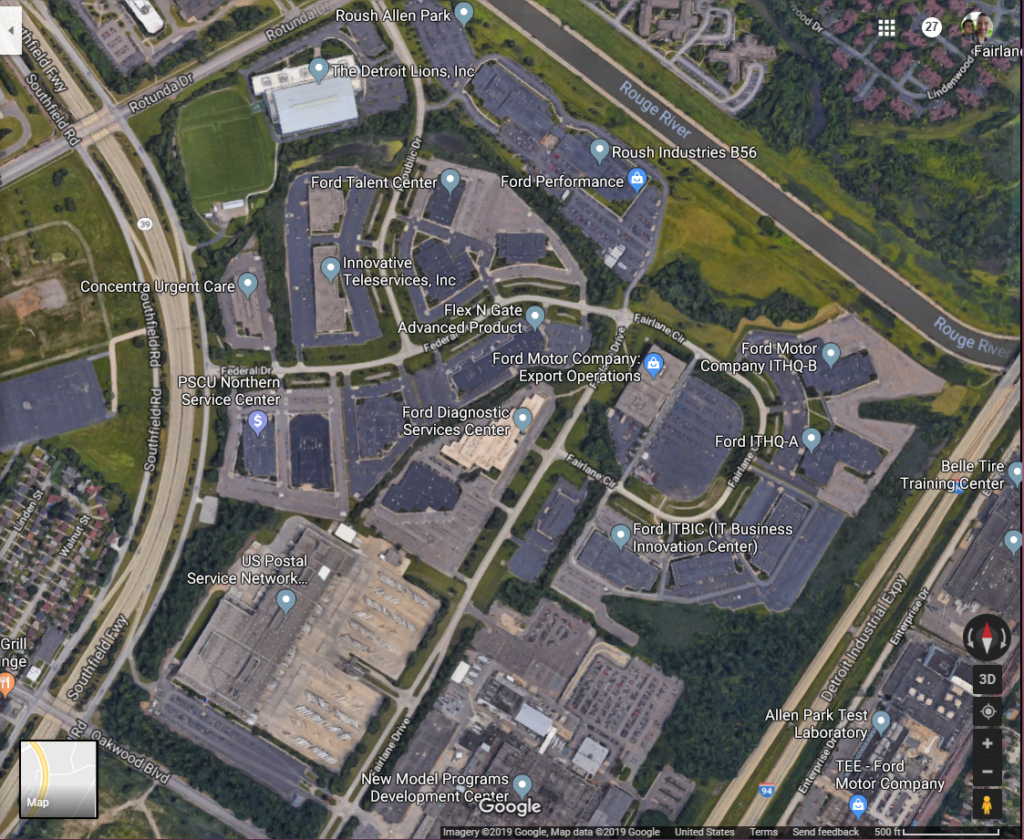
One square mile of suburban Detroit. Note the amount of space wasted on accommodating cars. Without the cars, you could house AND employ about 50,000 people with this much land.
I thought that would complete my social media indulgence for the day, but NO, things were just about to get interesting.
That night, an MMM reader who also happens to write for Forbes, wrote to me asking if he could do a story about Cyclocroft. He also pulled in the designers Tara and John from B4Place. And the next day, this rather racy article showed up in the news:
Whoa there, Forbes!
While the story was technically accurate, calling me a "Wealth Guru" instead of an "Early Retirement Blogger" definitely amped the intensity. And words like "Plans" and "has teamed up with" made it sound like things were very imminent and real, rather the just a set of pretty pictures I was happy to share.
But the world started to react as if Cyclocroft really were real. Twitter responses and emails started coming in from people who would buy properties and move there, if we really built it.
Even more notably, my email inbox and even the voice mail of my supposedly private mobile phone, started filling up with notes from news agencies and big players in finance and real estate, asking if they could do news stories and/or help get involved in building Cyclocroft.
Forbes - Wealth Guru Plans Dutch-Style Car-Free Bicycle-Friendly City Near Boulder, Colorado
Curbed - Could a car-free, Dutch-style city work in Colorado?
The Real Deal - Imagine a city with no cars, free bikes - and 50,000 people in one square mile
The Chief Marketing Officer of the nation's largest mortgage providers (who I was surprised to learn is also a longtime Mustachian) came to my coworking space and we talked for two hours about whether we could make it a reality. Because, aside from the potential to improve world through better design, residential housing is the world's largest market, worth trillions of dollars.
Now, just in case you have any illusions about Mr. Money Mustache's superpowers, it is important to remember the real story. I am a retired, stay-at-home Dad who occasionally types shit into the computer, and that's the end of it. On the average week my biggest "business" meeting is a Tuesday morning workout in the back yard of the HQ for some squats or deadlifts with a friend or two.
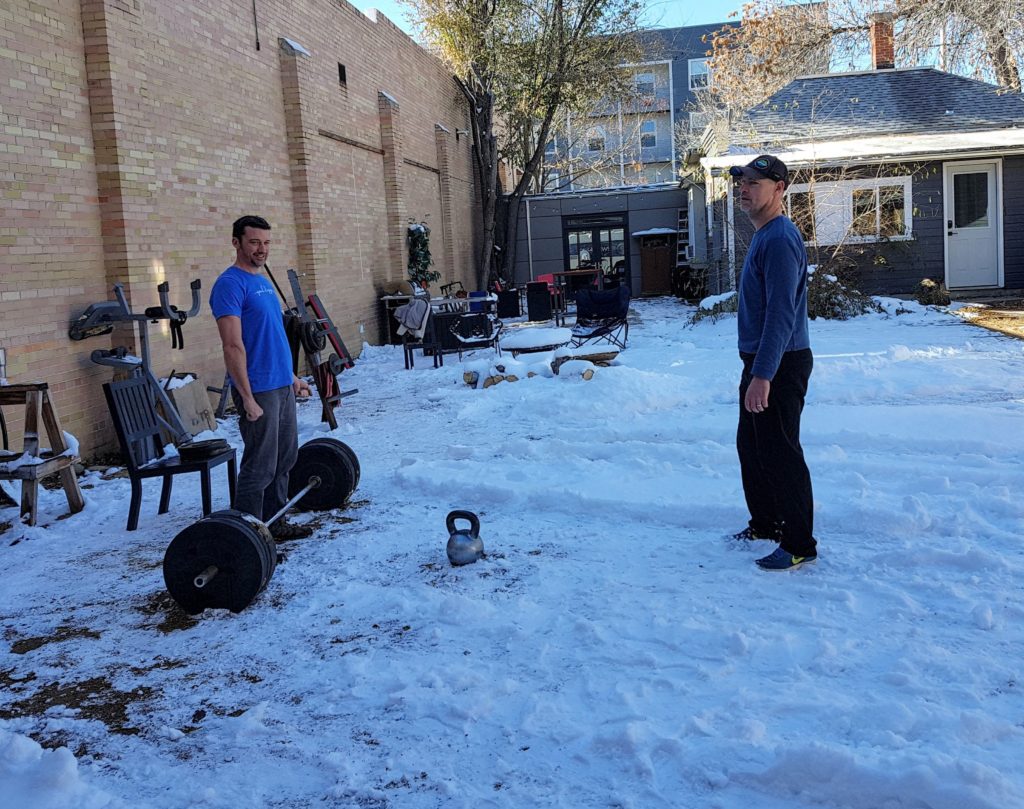
Actual day of work. Does this look like a City Developing Wealth Guru to you?
Now, this Cyclocroft bonanza is still cause for celebration - all this attention and energy will definitely not go to waste. I really do plan to nudge this country towards its rightful status as a Badass Utopia - it's a lifelong project for me, and we are only about eight years in. It's just that Starting a City right now does not play well with my other project of Raising a Boy, a contract which still has about five years left on it. I'm not a great multitasker so anything outside of that job has to be low-stakes and with complete flexibility.
But there's still is a heck of a life lesson in this story, that can help all of us change our lives. It's on par with the lessons of the Optimism Gun, and the Circle of Control.
The lesson is to Begin with the End in Mind - and Start by Painting a Beautiful Picture of that end destination.
It's the technique at the core of the world's best marketing and negotiation strategies, and it works so well because it short circuits the human brain into making everyone - including you - see things in the desired way.
I've known this for a long time, and applying it is the reason for most of the successes I've had in life so far. Yet I still sometimes get sloppy and fail to use it, and sure enough many of my failures can be tracked back to that sloppiness. Let's check out a few examples of Painting the Picture in real life so you can see exactly how this works and how powerful it is.
When I started this blog in April of 2011, I didn't just start rambling about interest rates or student loan debt. And I definitely didn't mention carbon footprints or get into environmental guilt-tripping. The first sentence of the first post is "What do you mean you retired at 30?"
Retired. At. 30.
It was a simple picture of a very clear end destination that automatically got people's imagination running and filling in their own details.
Everyone knows that a 30-year-old is a fairly young adult with lots of promising life ahead of them. And everyone knows that "Retired" must mean some unusual financial accomplishment was involved, which makes them imagine what their life would be like with that sort of money.
In retrospect, that marketing decision was the main thing that has made the MMM blog catch the attention of newspapers, which in turn brought in the readers, which in turn kept me motivated to keep writing it. So painting that initial picture was an amazingly big leverage point.
And Cyclocroft worked in exactly the same way. You've heard me harping almost daily about "live close to work and ride a bike", but this produces only small changes in the world. You are still fighting the car-based design of your city, your car-loving spouse, and all of the excuses that pop up from looking at the small day-to-day picture.
But Tara and John bypassed all of those arguments by sharing a simple, beautiful picture of the end lifestyle, with just enough detail to provide a framework that got everyone's imagination running.
Car-free city. Next to Boulder. 50,000 people.
People read these key points and see the pictures, and in their minds they are already nestled into this bucolic town in the Sunny Western US at the base of the Rocky Mountains. For most people, the sale is already made and now they are ready to hear the details - most importantly "How can I get you my money?!"
Once you go looking for this pattern, you see it everywhere, especially in the most successful bits of persuasion in the world.
Tesla almost completely took over the coveted luxury car market with no paid advertising, even while its competitors fought tooth and nail with their old ads, by painting a clean-slate picture: clean, beautiful, prestigious cars that are the fastest in the world. They were introduced to the world as if they were movie stars, rather than squeezed out through the crusty sphincter of an old corporate marketing department as most cars are. They can even make a commercial hauling appliance into a rockstar that has everyone waiting breathlessly for its world-changing arrival.
So How Can You Use This Amazing Power on Your Own Life?
We can see how this works by painting a few pictures of our own:
You want less money stress in your life:
Describe the picture of your ideal financial life. Your house is paid off, the kids are well cared-for, and you think about money no more than you think about tap water. It's just there, so instead you spend your time figuring out how to get more fulfillment out of each day.
Then to get there, you suddenly feel the motivation to streamline your spending (and perhaps optimize your earning) today. It's no sacrifice to skip over a car upgrade, if it rockets you towards this clear picture of your future life, right? And conversely, making the car upgrade is suddenly less appealing if it means you will be extending your time on Cubicle Lockdown by three more years and pushing off the beautiful picture you have painted for yourself.
You wish your spouse was on board with more frugal living:
You won't get anywhere by nagging your partner that she needs to take shorter showers or telling him to give up his Porsche convertible. The only hope of teamwork is to agree on the end goal: do you want financial freedom more than you want the Porsche, or not?
Well then, what does financial freedom look like? Perhaps it includes being able to stay home to raise children, or to have more time to travel together, or to pursue part-time meaningful work instead of full-time-just-because-I-need-the-money careers. Or something else you can both agree on. This article on Selling the Dream describes a case study where this method worked beautifully for a couple.
Once the dream is there, the daily steps that move you towards it become easy and obvious.
You want to earn your dream job
Rather than sucking up to the company or stepping through your individual qualifications and acronyms of all the programming languages you know, begin your campaign as though you've already won.
Describe (with beautiful pictures of your past work and future proposals if appropriate), the way that things will work, once you are working with the company. The ways you are excited to build the culture of the group you will be joining and managing, and why that is destined to influence the entire company over time. This vision of you excelling in this job needs to become a crystal clear anchor in the company manager's mind, that lodges itself in as the way things are going to be. From there, it becomes difficult to dislodge.
These same principles work in both large and small situations, for persuading any range of people from just you up to the entire Human population. From getting into better physical shape to winning an election.
My own Failures to Paint the Picture
When I look at my own areas of less-than-satisfactory performance in recent years, they all carry the hallmark of scraping along from one daily hardship to the next, while neglecting the big picture.
My former wife and I did not keep our own marriage alive, and it may be partly because we didn't think of what we wanted a good marriage to look like. We just reacted to the ongoing realities of daily life, doing more damage as time went on.
My son copes with some anxiety and can tend to be an extreme homebody, avoiding all new situations if not challenged to do otherwise. But if you work at it, you can get him out for adventures, and he always has a great time. And his Mom has shown much greater skill than me in making these things happen.
But far too often during our days together, I will make a few offers to go out and do things together, then give up and feel deflated when he rejects them. And I come back the next day and try the same thing, and I usually get the same result.
But if I paint the bigger picture well in advance - for example of a two-night camping trip with his favorite friends and their dads and kayaks and sand dunes - the chance of a breakthrough greatly increases.
The recipe for change is right here in front of all of our faces. It's up to us if we are bold enough to paint the picture, and then do the work that will become obvious once that picture is hanging on the wall in front of us.
Okay, but When Do We Get To Move to Cyclocroft?
I am happy that this big, beautiful picture of the future of North American city planning is now out there, creating an anchor in the public mind that is bound to stick. That alone is an amazing accomplishment.
For my part, I'd love to help out in many ways. But at the same time, the picture I have painted for my own life does not involve being a property developer. I've done that on a small scale in the past and learned there are other people that thrive on the phone calls and meetings and contractor cat-herding much more than I do. So as much as I'd love the results, I'm not willing to do the work. And this is a great thing to know about myself, because chasing accomplishment and prestige and things that seem "important" is not necessarily the path to a happy life, if you don't enjoy the work along the way.
But with the right group of people working together on the aspects they truly enjoy, it really could happen. Tara and John like designing spaces. I like describing things to the world, but also solving physical and engineering problems. You might like running a restaurant or a bike shop, or playing in a jazz trio. It takes all sorts of people to build a new city and change a culture, but as long as we are all working on the same end goal in mind, we will definitely get there.
--
* Never mind that this particular chunk of beautiful land is currently a NOAA facility! The real point is that when you only need one square mile, you can fit a world-changing city almost anywhere, including into the corner of an existing large family farm.
